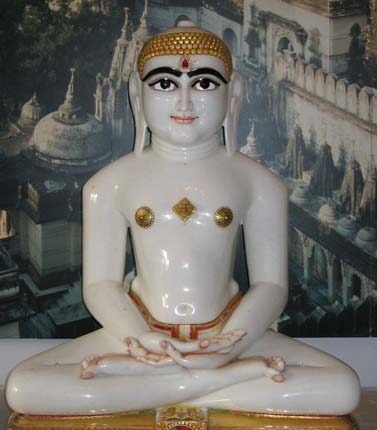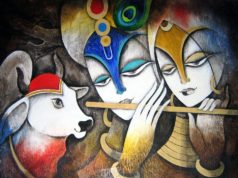Three Jewels of Right Faith, Right Knowledge & Right Conduct are the path leading to peace and purity – Jainism
Mahavira, which means, The great hero was the 24th avatar of Jainism who preached non violence, urging his followers to show kindness to all creatures, be a vegetarian and follow the path of ultimate truth. He lived at the same time as the Buddha and like him, rejected the two Hindu notions of the social system of caste and the rituals of sacrifice. He was a Prince who is believed to have lived in a place called Kundagrama, in Bihar state. A memorial has been built there and a center set up for Jainism and non violence. Mahavira left his home at the age of 30 to become an ascetic, a religious person who practices self denial. He plucked out his hair, discarded his clothes and wandered for twelve and a half years, fasting and practicing severe penances in his search for truth. At the age of 42, he attained enlightment and possessed the divine experience of understanding truth. For the next 30 years, Mahavira traveled across northern India teaching an ascetic path to purity and peace. The Jain book called ‘Kalpa sutra’ records his death at Pava (modern Bihar) at the age of 72 leaving behind him thousands of followers who later formed two sects, the Digambara (naked) and the Svetambara (clad in white). Jains believe that all human beings, animals, insects, plants and even earth, stones, fire, water and air have living souls i.e. jiva. Jains think of karma as ‘atomic particles’ which cling to soul. Deeds of violence, greed, selfishness, dishonesty, sexual misconduct and covetousness obscure the soul. Acts of gentleness and penance lighten and liberate it.
Jainism Prayer
The Navakär Mantra is the most important mantra in Jainism and can be recited at any time. While reciting the Navakär Mantra, Jains bow down to Arihanta (souls who have reached the state of non-attachment towards worldly matters), Siddhas (liberated souls), Ächäryas (heads of Sädhus and Sädhvis, Shrävak and Shrävikäs), Upädhyäys (those who teach scriptures and Jain principles to the followers), and all Sädhus and Sädhvis (monks and nuns, who have voluntarily given up social, economical and family relationships). Together, they are called Pancha Paramesthi (The five supreme spiritual people). In this Mantra Jains worship their virtues rather than worshipping any one particular entity; therefore, the Mantra is not named after Lord Mahävir, Lord Pärshva-Näth or Ädi-Näth, etc. When Jains recite Navakär Mantra, it also reminds them that, they need to be like them. This mantra is also called Namaskär or Namokär Mantra because in this Mantra they offer Namaskär (bowing down) to these five supreme group beings. Recitation of the Navakär Mantra creates positive vibrations around us, and repels negative ones.
The Navakär Mantra contains the foremost message of Jainism. The message is very clear. If we want to be liberated from the cycle of life and death, we need to renounce worldly affairs by becoming a monk or a nun. This is just the beginning. If we stay on the right path, we will progress to a higher spiritual state, Kevali or Arihanta, and ultimately proceed to become Siddha after nirvana (liberation from the cycle of birth and death). The goal of every soul is to become a Siddha.
Generic Meaning of Pratikraman
It Means:
To Come Back
To retreat from the worldly sins
To get away from the tendency of Finding fault in others, criticizing others and to develop the habit of self analysis, self improvement, and introspection
Repentance/atonement
Types of Pratikramans
Devsi(Evening)
Raishi(Morning)
Pakkhi (Fortnight)
Chaumasi(4 mos.)
Samvatsari (year)
Pratikraman as per different Traditions:
DIGAMBAR TRADITION
STHANKAVASI TRADITION
TERAPANTHI TRADITION
SWETETAMBER MURTIPUJAK TRADITION
Shrimad Rajchandra Tradition
Some terms:
Samayik
A process to obtain serenity, tranquillity, and mental equanimity
Chauvvisantho
Offering our prayers to 24 Tirthankars
Vandana
Salutation to saints and monks to develop humility
Pratikraman
To repent the sins already committed and be careful that they are not repeated in the future
Kayotsarg
To be engrossed in the observation and analysis of one’s soul and forgetting one’s physical body
Pratyakhyan
To take a vow to abstain from certain activities
Namaskär Mahä Mantra
Namo Arihantänam
Namo Siddhänam
Namo Äyariyänam
Namo Uvajjhäyänam
Namo Loe Savva Sähunam
Eso Pancha Namukkäro
Savva Päva Ppanäsano
Mangalänam Cha Savvesim
Padhamam Havai Mangalam
Namo Arihantänam: I bow down to Arihanta,
Namo Siddhänam: I bow down to Siddha,
Namo Äyariyänam: I bow down to Ächärya,
Namo Uvajjhäyänam: I bow down to Upädhyäy,
Namo Loe Savva-Sähunam: I bow down to Sädhu and Sädhvi.
Eso Pancha Namukkäro: These five fold reverence (bowings downs),
Savva-Pävappanäsano: Destroy all the sins,
Manglänancha Savvesim: Amongst all that is auspicious,
Padhamam Havai Mangalam: This Navakär Mantra is the foremost.
Namo Arihantänam
I bow to Arihantas who have achieved enlightenment by overcoming inner enemies and weaknesses, who have attained infinite knowledge, infinite bliss, and showed us the path, that brings an end to the cycle of birth and death.
Namo Siddhänam
I bow to Siddhas who have attained the state of perfection and immortality by liberating themselves of all Karmas.
Namo Äyariyänam
I bow to Ächäryas who are the heads of religious order and who practice the supreme virtues.
Namo Uvajjhäyänam
I bow to Upädhyäys who are well versed in all Ägams and teach the same to the deserving pupils and other followers.
Namo Loe Savva Sähunam
I bow to all the Sädhus and Sädhvis (monks and nuns) that follow the five great vows of conduct and inspire us to live a simple life.
Eso Pancha Namukkäro. Savva Pävappanäsano
These five-fold obesisance is eradicator of all sins.
PARYUSHAN PARVA & THE FESTIVAL OF FORGIVENESS
“MICCHAMI DUKKDUM TO ALL JAIN FRIENDS & WELL WISHERS OF KIDSFREESOULS.COM”
Paryushan, the most important Jain religious festival observed by Shvetambars (8 days festive spirits) and Digambars (10 days festive). This period is intensive reading, reflection and purification with fasting and reading of Mahavira – 14 dreams of his mother and followed by story of his life, birth, life and liberation.
For Shvetambars, the final day of Paryushan is “Samvatsari Pratikraman – the annual confession. The ritual of asking for forgiveness from the teacher is widened in scope to include family, friends and all living beings. Giving and receiving forgivenss – universal friendship. The word “Micchami Dukkdum” which means
“Saying sorry for knowingly or unknowingly hurting someone with words or actions”
SIXTEEN DREAMS OF MAHAVIR’S MOTHER:
Just before Mahavira was born , His mother had sixteen dreams. Mahavira was born at four in the morning, which is considered very auspicious in Jainism and Hinduism.
Her sixteen dreams were:
A white elephant
A lion
Goddess Lakshmi with two elephants at her side showering flowers
The moon lighting the universe with silvery beams
A pair of jumping fish
The radiant sun, a golden pitcher
A lake full of lotus flowers
A calm ocean of milk
A celestial palace
A throne of rubies and diamonds
A celestial king ruling the earth
A garland
A white bull
A fragrant Mandara flowers
and a vase as tall as Mount Meru, filled with gems.
And immediately after this, she felt a white elephant enter her through her mouth. She also didn’t feel any pain associated with childbirth.
Paryushan
The word Paryushan has several meanings: Pari + ushan = all kinds + to burn = to shed our all types of karmas. To shed our karmas, we do 12 different types of austerities including fasting.
Another meaning of ‘ushan’ is to stay closer to our own soul from all directions and to stay absorbed in our own self (soul), we do swadhyay (self study), meditation, austerities, etc.
APari + Upshamana = upshamana means to overcome, to overcome our passions (kashyas – anger, ego, deceit and greed) from all directions.
Five Vows:
*To practice non violence or ahimsa by not causing harm to any living being
* By speaking the truth and follow Satya
* By refraining to steal and by not taking anything that is not given willingly
* By following celibacy by avoiding sensual pleasures
* To remain detached and so follow non possession or aparigraha.
Jain Websites
Jainism Principles, Sources, History
Jain Data Base for Articles & Books
Dictionary for Traditional Jain Words
Link to more Inspiring Jain stories
Bhaktamar Strotra, Mahaveer Stotra & more
Jain Philosophy & Sacred Books








